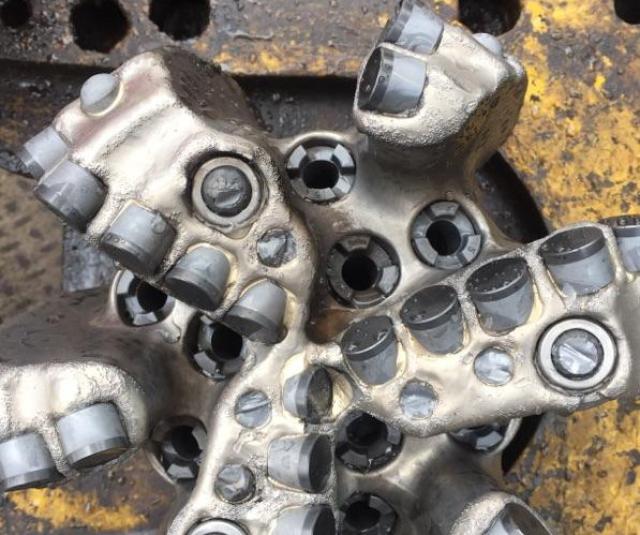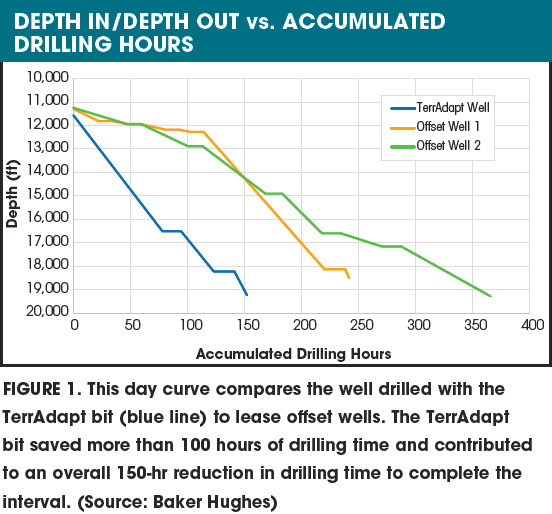
A TerrAdapt bit’s dull condition after the run is shown. The adaptive bit showed significant dull improvement, contributing to improved drilling efficiency. (Source: Baker Hughes)
The vast majority of well intervals are drilled through interbedded formations, where rapid changes in lithology create drilling challenges for conventional polycrystalline diamond compact (PDC) drillbit designs. These bits typically feature a single fixed depth-of-cut (DOC) control setting that is optimized for a single rock type and cannot be changed once the bottomhole assembly (BHA) is in the hole.
A fixed-DOC bit will drill smoothly in some areas but perform erratically and inefficiently in others because of torsional vibrations that arise as the bit transitions between different rock types. These vibrations lead to the well-known phenomenon of stick/slip in which the bit’s bite becomes too aggressive, causing it to “stick” and stop rotating. Meanwhile, the drillpipe behind it continues to wind up like a spring until the bit releases, or “slips,” and starts spinning uncontrollably.
Stick/slip events dramatically increase drilling costs by reducing the ROP and can seriously damage the bit and other mechanical and electrical BHA components. Operators often have to make extra trips to replace the bit or BHA, which adds significant rig time to drilling operations. Or they may choose to continue to drill with diminished performance and risk falling short of their target depth.
A smarter bit
Stick/slip problems arise in these wells because the fixed-DOC bits cannot sense or adapt to changing conditions downhole. In response, Baker Hughes has developed its TerrAdapt adaptive drillbit, the industry’s first “smart” bit to proactively mitigate stick/slip using adaptive DOC control technology.
The adjustable bit automatically regulates its DOC based on changing lithology—with no interaction or control required from the surface. When torsional vibrations are first detected, adaptive DOC elements extend to maintain a stable drilling profile. These elements, which are contained in cartridges installed among the PDC blades, can fully retract in tens of seconds and quickly extend in milliseconds to prevent sudden changes in DOC that might lead to stick/slip. As vibrations subside, the elements retract back into the cartridge, thus optimizing ROP for the bit.
The adaptive bit provides better control of stick/ slip events than conventional PDC bits could possibly achieve. Traditional control methods include designing the PDC bit with a precise DOC for the entire run based on the rock composition and hardness expected while drilling the well. This is a guessing game in many instances, particularly since the formation can change in unexpected ways along the wellbore. Setting the DOC limit too high risks dramatically lowering the ROP and extending rig time. Conversely, too low a limit may do nothing to prevent stick/slip in certain areas of the well.
The second common method for mitigating stick/ slip requires the operator to adjust the weight on bit (WOB) or rpm from the surface. If the onset of stick/ slip is suspected, the driller will typically decrease the WOB or rotate the string faster. The bit might react to these changes by going into a different kind of vibration mode that accelerates tool wear or damages other components of the BHA’s hardware and electronics.
Another challenge with this approach is that it is imprecise. The driller cannot quickly or accurately know exactly what is happening at the bit, which may be thousands of feet downhole. And once a solution is enacted, it takes time to understand if the changes resolved the problem.
But by adjusting the DOC control in response to drilling conditions, the new bit responds intelligently to torsional vibrations. The control elements quickly adapt to mitigate a downhole dysfunction. And because the bit responds in real time, it avoids the need for the driller to be notified of a downhole problem at the surface and then wait longer to take corrective action.
The bit’s design also minimizes impact damage, with hydromechanical ovoid elements that absorb any sudden overload or shock that threatens the integrity of the cutting structure. By preventing dynamic instability and cutter damage, the bit helps extend bit/BHA life, increases footage drilled and lowers nonproductive time.
The adaptive bit is available in sizes ranging from 8-³⁄8 in. to 12-¼ in., which meets the majority of global drilling needs, and can be used with different numbers of blades and cutter sizes. While three cartridges are the most common design, the adaptive bit can be configured with four cartridges if deemed necessary.
Delivering results in early wells
After successfully proving the adaptive bit concept in 2014, the service company’s development team began work on a field version of the bit. Soon after the successful completion of qualifications tests in its own testing facilities, Baker Hughes lined up several operators experiencing torsional vibration issues who were willing to evaluate the adaptive bit.
In one well the adaptive bit increased the operator’s ROP by 27% compared to the average ROP on offset wells drilled through the same interbedded formations. The bit reduced torque variations by 90%, indicating dramatically reduced stick/slip. It also enabled the operator to drill 217 m (713 ft), or 27%, farther and use significantly less energy than on nearby wells drilled with traditional PDC bits.
Another operator used the bit to help drill curve and lateral wells in the Austin Chalk Formation in southeast Texas. The operator wanted to land and complete an entire 8-½ in. curve and lateral in a test well using one BHA. Previous attempts resulted in a less than 20% success rate due to inconsistent bit dulling from run to run, which led to erratic bit damage and performance. Motor and downhole tool failure also were common outcomes.
The service provider and operator jointly reviewed past run performance and dull conditions, which led them to suspect that stick/slip and other dynamic instabilities caused the limited performance. An 8-½ in. six-bladed adaptive drillbit was proposed to reduce torsional oscillations and stick/slip and thus improve overall performance and consistency.

The adaptive bit drilled 1,508 m (4,949 ft) in 78 hours, resulting in an overall ROP of 19 m/hr (63.4 ft/ hr). The tool successfully landed the curve and drilled almost 1,219 m (4,000 ft) of the lateral before being pulled for a nonbit-related issue. And compared with the lease offset wells drilled previously, the new bit saved more than 100 hours in total drilling time for equivalent footage, contributing to an overall 150-hr reduction in the time required to complete the interval (Figure 1). The adaptive bit’s dull condition was significantly improved over offset wells as well. Inbit vibration measurements verified that the bit drilled the interval with no stick/slip and very low vibration measurements overall. The lack of damage to the cutting structure helped the bit achieve greater drilling efficiencies—more wellbore drilled in less time.
Recommended Reading
Delivering Dividends Through Digital Technology
2024-12-30 - Increasing automation is creating a step change across the oil and gas life cycle.
E&P Highlights: Dec. 9, 2024
2024-12-09 - Here’s a roundup of the latest E&P headlines, including a major gas discovery in Colombia and the creation of a new independent E&P.
E&P Highlights: Dec. 16, 2024
2024-12-16 - Here’s a roundup of the latest E&P headlines, including a pair of contracts awarded offshore Brazil, development progress in the Tishomingo Field in Oklahoma and a partnership that will deploy advanced electric simul-frac fleets across the Permian Basin.
Shale Outlook: E&Ps Making More U-Turn Laterals, Problem-Free
2025-01-09 - Of the more than 70 horseshoe wells drilled to date, half came in the first nine months of 2024 as operators found 2-mile, single-section laterals more economic than a pair of 1-mile straight holes.
Tracking Frac Equipment Conditions to Prevent Failures
2024-12-23 - A novel direct drive system and remote pump monitoring capability boosts efficiencies from inside and out.
Comments
Add new comment
This conversation is moderated according to Hart Energy community rules. Please read the rules before joining the discussion. If you’re experiencing any technical problems, please contact our customer care team.




